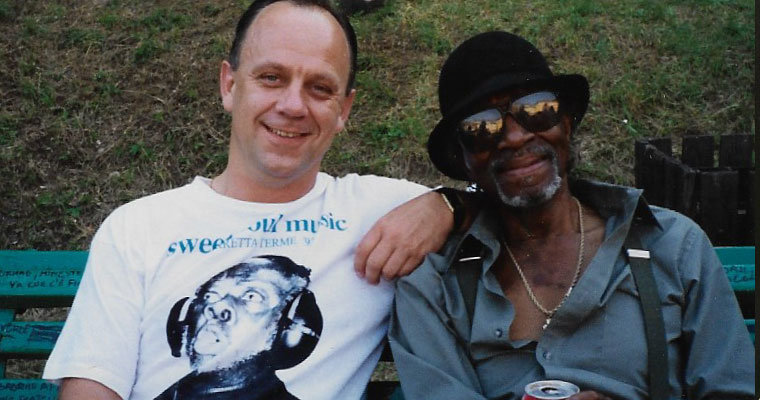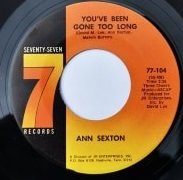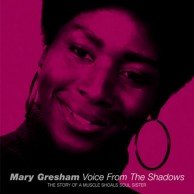Hit and Run! An Interview with Garry Cape.
The Yorkshire Soul Connection...

By E. Mark Windle. March 2020
When I asked reissue / retrospective soul label owner Garry Cape about the motivating factors for his 2020 return to the soul market with the reactivation of his Hit and Run label series, issues of mortality seemed to be at the top of the list:
“I guess it had something to do with my good friend John Anderson becoming ill and passing away recently. It made me think. I’d had some health issues a few years back. What if I was gone? I generally work alone. So I’m sitting on a bunch of unreleased recordings that would potentially never see the light of day, and that would be a real shame.”
The Garry J. Cape story starts in the early to mid-1960s. Garry is a name well known to a number of soul fans and record collectors across a number of scenes, both through independent activities and his collaborations with John Anderson. I read a comment somewhere that the northern soul scene found these two individuals, not the other way around; reflecting their eclectic taste for a wide range of deep sweet and southern soul, some which fitted the northern scene perfectly even if not by design:
“Where do I start? I have an interest in all things Americana. My first entry into the world of soul in the 1960s was an appreciation of American music through hearing cover versions by UK artists on the radio and TV as a schoolkid. My longer-term interest was probably initiated through being hooked on the Stax and Atlantic R&B releases of the time. I was at an age where you wanted to stand out as an individual. Whilst most of my friends were interested in Detroit and Chicago sounds it felt like I was the only around who was immersed fully in the southern soul, and I was doing that by buying imports. Most kids I knew who were into soul would go straight to the Dave Godin pages when the Blues and Soul magazine came out. For me, it was the John Abbey section. Southern soul was his thing and it struck a chord with what I was listening to at the time. I was soon buying from Ernie Young’s mail-order from Nashville, and Stan’s in Shreveport, Louisiana. It took an age to order and receive these records from the States, but I was still generally getting them before any happened to be issued on UK labels. I turned my hand to buy and selling records to schoolmates.”
Eventually Garry left school to work for the civil service in the tax office, while continuing to deal in record sales on an informal, part time basis. The first move toward reissuing music possibly originated from his mail order dealings with Ernie Young in Nashville. Young owned the legendary Excello records, home of licenced in swamp blues as well as local R&B, gospel and eventually soul music.
Ernie’s Record Mart was located on 179 Third Avenue. Ernie Young (the uncle of WSOK founder Cal Young) was primarily interested in selling records but used his own shop to set up the gospel orientated Nashboro label and then Excello a year later. Excello was to become one of the most successful and prolific Nashville early R&B labels. Ted Jarrett, in his biography “You Can Make It If You Try”, commented on the cramped conditions artists had for recording at Ernie’s place; gospel would be recorded on the bottom floor of the shop with a simple microphone set up, and R&B upstairs in a small room. DJ Morgan Babb would broadcast his show from Ernie Young’s record shop window in the early 1950s. At its peak a decade or so later, around a thousand mail orders were reported to processed on a daily basis, including soul 45s sent to collectors in the UK and Europe.
A symbiotic relationship existed between Ernie Young and DJ John Richbourg who worked for Nashville’s WLAC radio station, one of the first in the US to broadcast R&B. Since the 1940s WLAC had a 50,000 wattage broadcasting capability, enabling twenty-eight states to receive a signal; reaching parts of Canada and the tip of Southern Florida. The primary intention of WLAC from the outset was to serve the relatively untapped black audience across the deep south. As “race music” became labelled R&B, Richbourg would run night-time shows, when the broadcasting signal was strongest. The coverage by WLAC had, in a literal sense, far-reaching effects. The station played a major part in giving teenagers – black and white - access to soul music in the south, and Richbourg would promote Ernie Young’s record mail order business on air.
Richbourg first got a taste for the recording business by using WLAC’s studio facilities to record gospel music, then gradually other facilities at Stax and American Recording Studios in nearby Memphis. His preference moved progressively towards recording R&B and soul acts, both for his own label in the early 1960s, and for lease to third party labels, culminating in a partnership with Monument owner Fred Foster which took the Sound Stage 7 label to great heights. In terms of soul music releases, Sound Stage 7 was certainly one of the most prolific to come out of Nashville, featuring Joe Simon, Ann Sexton, Roscoe Shelton, Roscoe Robinson, Jackey Beavers, The Avons, The Valentines, Latimore Brown and several others. Richbourg’s production and artist management skills and activities were pooled under the J.R. Enterprises banner. Raw local talent and in-leasing of artists from other parts of Tennessee and the cities of the north ensured longevity for the label.
A departure from WLAC occurred in 1973 after disagreeing with the station’s decision to change musical programming towards a mainstream pop format. Richbourg’s attention turned to creating new labels, Seventy Seven and Sound Plus. He was still utilising some artists from the Sound Stage 7 days, but also finding new singers like Ann Sexton. As he owned the old masters as part of the severance deal with Fred Foster (when Foster decided to close the label to concentrate on his country music interests), he was also in a position to reissue tracks.
“I'd already been doing quite a bit of business with John Richbourg by mail starting in the mid-1970s. At that point I was about the only English dealer selling to Japan” Garry remembers. “He started reissuing a lot of deep soul from Sound Stage 7 on his Sound Plus label. I also developed a market in Holland with the Surinam guys who were into the same stuff and was buying thousands of Sound Plus 45s from him by this time. I met John face to face in Louisiana in 1978. He had a brother in New Orleans, so he drove down from Nashville and we had spent some time together. He was a great guy, always very courteous. He tried to sell me his masters but I declined. Seems kinda nuts now but at that time he'd just leased them to Japan who had produced a range of related LPs. I also had J.R. repress several things for me which he had not already done. Sometimes they would be on Sound Plus. Sometimes they would end up being on his other label Seventy Seven as he had thousands of untitled labels which he needed to use up! I recall having him press me 5,000 copies of Ann Sexton - I sold half of them in the UK for the Northern side and the others in Holland and Japan for the deep flip.”
Now in his late twenties, Garry had to make a career decision. “I was at the point where I was ready to take on record dealing full time. I’ve never liked to be idle and found that I was working on the day job all day and spending every evening selling records. I was young enough to take a risk. I knew I had the income tax career to fall back on if things didn’t work out. For the first few years things went well. I was importing records from the US and selling to the UK, Europe and Japan, trading as Black Grape.”
Hit and Run, the first Cape-owned imprint, was also established during this time. Garry was in touch with Stewart Madison of Alarm Records in Shreveport, Louisiana. Madison would eventually move onto Malaco, and Garry does not deny the impact Madison had on opening various doors to artists and unreleased material over subsequent decades. For Hit and Run 5001 “Married Lady” / “Are You Living With The One You’re Loving With?” by Murco recording artist Eddie Giles was chosen. Both sides did see a 45rpm release in 1973 (Alarm 106), though most subsequent releases would consist of unissued songs from Bobby Sheen, Bobby Patterson, Erma Shaw and others.
“Hit and Run has always been around, I’ve always kind of had it as a label. Pressing runs were usually around 500 each time. A short series of 45rpm releases also appeared on Special Agent. I did these for the Dutch market, who were interested in deep soul and I’d been asked for certain recordings. For that reason I kept the imprint separate from Hit and Run. It was basically more of a straight-forward business arrangement providing a service for a third party, and carried releases from artists like the Ohio Players, Herman Hitson, Johnny Adams and Percy Milem. Eventually I had issues with the people from Holland, and things came to an end when they started sourcing their own artists.”
By the early 1980s, Garry was finding it harder to sell 45s. He returned to his income tax career, and thought it was time to sell his stock. “In my head at the time I just wanted out of the game. I attempted to sell it all to Soulbowl but even John was finding it hard for while at least. So, it was another ten years in the tax office full time, with little activity in soul music business for me. Then in the mid-nineties tax office were scaling things down – they offered a redundancy package and I took that to start importing 45s again in 1996.
“Both John Anderson and I were importing stuff together over thirty years, going back and forward to the US. We kept running into each other because of the nature of the work and we’d turn up at the same music festivals. We both had stuff that we wanted to put out. I’d say the two individuals who have influenced my career directions in the soul label field have been John Abbey and John Anderson. I was never into hardcore northern soul as such and didn’t necessarily follow John Anderson from the angle of digging for hard to find 45s. But he was like an older brother to me who I respected and admired for the business he had established over the decades.
A ‘new’ Grapevine label seemed to be a logical vehicle for our collaboration. Initially John wasn’t keen on the idea, thinking Grapevine imprint was done and dusted as a concept. But I felt that adopting the name would be a positive. Eventually we settled on Grapevine 2000. We became formal business partners setting up the Grapevine Music Group and released over sixty 45s and thirty-five CDs over a seven-year period. Grapevine only came to an end, when John had a desire to move into more contemporary recordings. Soul Junction was started to deal with this product. I eventually came out of it and Dave Welding stepped in with John to continue the label.”
Grapevine 2000 would showcase an eclectic mix of recordings including rare 1960s soul such as The Magnetics and The Servicemen, and unissued or hard-to-find 1970s / modern soul recordings such as Guitar Ray, Sandra Wright and Choice of Colour.
The Soulscape CD series was to be the next venture for Garry, aiming towards a southern soul market:
“I had access to the master tapes from Malaco. They had purchased the songs owned by Muscle Shoals Sound song writers. I found all these song writer demos – literally thousands of them. Admittedly certain tracks you only needed to hear for five seconds and - wow - no thanks. But lots of great quality material too. Listening through all the tapes was a hard slog but I am particularly proud of getting two albums out on George Jackson and another two by Philip Mitchell, both presenting recordings from their 1972-74 period. Another achievement for me was finding Mary Gresham. Previously she was unheard off; she did have a couple of singles out but they were by her and her ex-husband. There are some great tracks on her album “Voice from the Shadows” (Soulscape SSCD7008). I released a couple of them on 45: “I’ll Never Let You Walk Alone Again” / “You’ve Never Really Loved Until You’ve Loved Someone” (Hit and Run 1501). I don’t think I have any product which didn’t turn out the way I wished. I’m not going to put something out if I don’t have faith in it. Otherwise it just isn’t worth the effort. Also to be fair I had a lot of quality material at my disposal. As I was in and around the Shoals area generally, other doors opened up for me which gave me access to future projects. I could never break into the FAME thing though as I think Rick Hall was holding out for too high a price for his stuff. Despite that, the Soulscape series was pretty successful, and I ended up doing thirty-one CD titles in the end.
I returned to the Hit and Run label in 2009. I was still getting calls about the Soulscape CDs and being asked if had I any plans about doing some 45s from them. So I put out a few which did well. A heart attack around that time though required a change in what I was doing. Health professionals were telling me to cool off a little. I was constantly travelling to the US, maybe four or five times a year and always on the go. I had to make some lifestyle changes. I still kept an ear to the soul scene but slowed right down. People would keep asking for the old Soulscape CDs, vinyl and the possibility of releasing more tracks. But again I was out of it….until now. John Anderson’s passing made me reflect on my position. I’ve nearly always worked alone, and somebody needs to put this stuff out in case it’s lost forever. With that, the Hit and Run label is now reactivated from 2020.
The focus has always been southern soul, featuring recordings taken from previously unreleased master tapes and occasionally from ultra-rare 45s. I’m now excited to get this product out. It’s a different selling landscape now compared to the 1970s and 1980s. I like the idea of working through social media and the internet as opposed to the wholesale world I used to operate in. It keeps me in touch directly with the buying market, and nice to build an interested customer base on platforms like Facebook. The idea for me at the end of the day is not to earn a huge income – at my age and situation I’m comfortable enough. But I like to keep busy, I’m not one to sit still and the passion for soul music is still very much there. My goal and dream now is just to get the music out there.”
Related Soul Source Articles
-
 11
11


.png.ea7971c534ca22dffbb22e5ae2ca90a2.png)
![soul ollie nightingale, 1993[11577] (2)](https://www.soul-source.co.uk/uploads-forum/monthly_2020_03/100902984_ollienightingale199311577(2).png.c30cd5d6fb4035105861091284903564.png)



Recommended Comments
Get involved with Soul Source
Add your comments now
Join Soul Source
A free & easy soul music affair!
Join Soul Source now!Log in to Soul Source
Jump right back in!
Log in now!